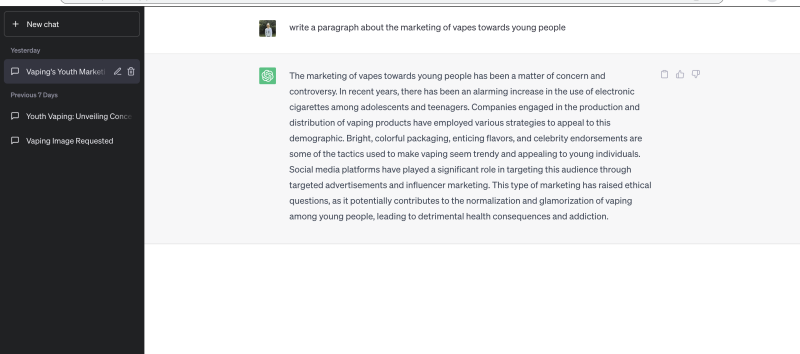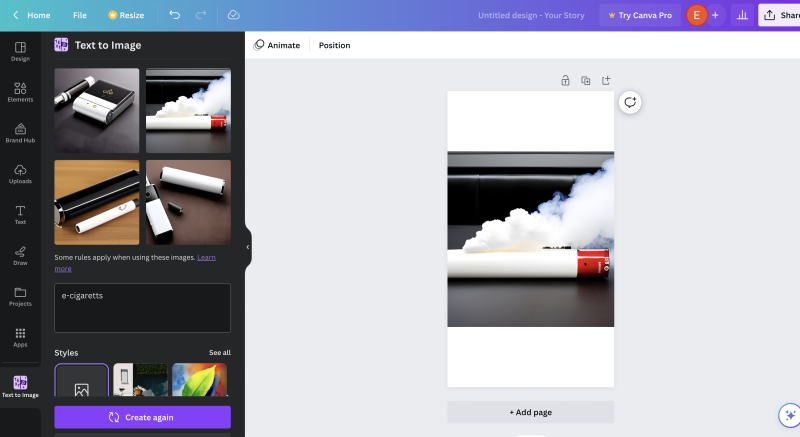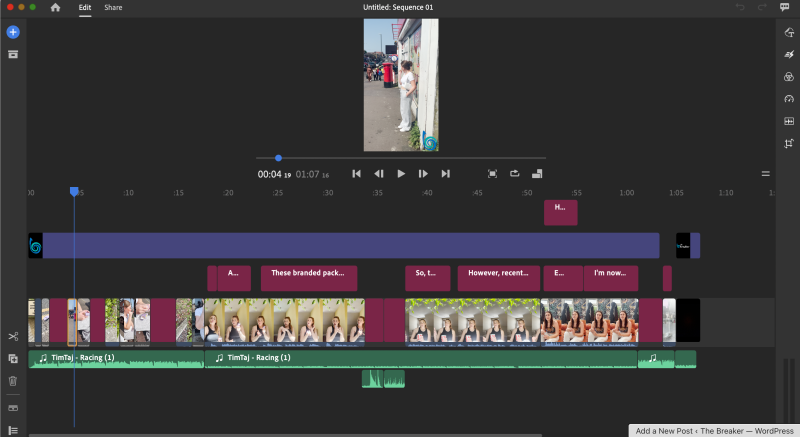The target audience for this feature article is people between 11-25 — in other words, people like me. Sometimes I wonder: how did I get to this point, having my morning cup of tea and a vape? I looked into the marketing of vapes and saw that it was aimed at young people and I wondered how many individuals have fallen into the same trap I have? Furthermore, what am I actually putting into my body? People in this age range can be influenced by trends as they spend a large portion of their life online or with friends. Vaping is a growing craze, and it is only now that scientists are discovering its effects on the body, therefore the sustainability of this article will be longer term as new discoveries are found.
A feature article incorporates different aspects of journalism in order to dive into a story enlightening public perception whilst remaining objective (Entman, 1993; Park and Nam 2015). I wanted this thematic feature article to highlight the issues of vaping in a boarder context- the different perspectives, marketing and health risks. I incorporated the “show don’t tell” concept into the piece describing the allure of vapes whilst the dense information was interweaved between the interviews (Tankard and Hendrickson, 1996). However, reviewing the piece objectively it would have been beneficial to interview more experienced individuals regarding branding and a healthcare professional who works directly with vapers/smokers to gain more depth. I included reports and studies to support the interview with the nurse and combined with the range of interviews and third person writing style it enabled limited bias and created a comprehensive piece.
Within the article I referred to individuals under 18 who vape however I chose to interview over 18’s due to consent. According to Ofcom and IPSO guidelines I would need to gain parental consent and assess issues surrounding identity (IPSO, Clause 6 2020; Ofcom, Section one, 2020). Therefore, I chose to include interviews from a teacher and a social worker discussing vaping in schools and with venerable people.
During the creation of this article, new government plans were released on how they were going to tackle underaged vaping use. Therefor the feature article has aspects of reporting within it to ensure it is current for the reader.
I used chat GPT to get inspiration for the article using prompts such as “write a 150word paragraph about vaping and marketing” or “write an introduction to a feature article on vaping” which allowed me to generate ideas.

Furthermore, I used Canva to formulate a cover image for the article. Originally, I used Nighcafé however I found Canva easier to use and crafted a better image. Some words such as vaping resulted in issues due to creating content that maybe harmful. I overcame this by using the prompt “e-cigarette” rather than “vape”. I found that the more detail I put into it the better the outcome.

There are legal issues surrounding the use of AI technology including copyright and plagiarism which need to be considered when creating a hybrid article (The copyright, designs and patents Act, 1998). I overcame this by crediting all AI assessed technology.
I created a teaser video for my article, incorporating facts for the watcher enticing them to read the full article. Incorporating graphics made the video more engaging, ensuring the subject of the article was clear and used music to tie the piece together building suspense captivating the audience. I used technology such as “adobe rush” to generate a clear sequence and image and “descript” software to generate subtitles so the video is accessible to all.

I realised after shooting some of the footage for the video that I could be sued for deformation due to incorporating packaging and brand logo’s whilst talking about the possible health hazards (The Deformation Act, 2013). In order to avoid legal-action I reshot clips using light and angles to remove any viable labels alongside using a variety of vape products.
I also incorporated 2x pieces to camera to explain what the article was about. When reviewing the piece, I feel as though I could have been clearer and focus on the camera more however the subject of the video is evident from both the graphics and the subtitles.
It is necessary for journalists to reflect on their work, use of language and framework techniques to review their outcome (Chalaby, 1996). In the construction of this reflection, I utilised Driscolls 3w’s (what, so what and now what) a long side a self-interview (Allen and Driscoll 2014; Keightley, Pickering and Allett, 2012). Through the development of this piece, I have realised that journalism not only provides the reader with information and objective viewpoint but can also push for innovation and change.
References
Allan, E.G. and Driscoll, D.L., 2014. The three-fold benefit of reflective writing: Improving program assessment, student learning, and faculty professional development. Assessing Writing, 21, pp.37-55.
Chalaby, J.K. Journalism as an Anglo-American Invention: a comparison of the development of French and Anglo-American journalism, 1830’s-1920s. European journal of communication, 11 (3), pp 303-326
Entman, R.M., 1993. Framing: Toward clarification of a fractured paradigm. Journal of communication, 43(4), pp.51-58.
IPSO, 2020. Clause 6, Children. Available at: https://www.ipso.co.uk/editors-code-of-practice/ (Accessed 25th May 2023)
Keightley, E., Pickering, M. and Allett, N., 2012. The self-interview: A new method in social science research. International Journal of Social Research Methodology, 15(6), pp.507-521.
Ofcom, 2020. Broadcasting codes section one. Available at: https://www.ofcom.org.uk/tv-radio-and-on-demand/broadcast-codes/broadcast-code (accessed 25th May 2023)
Park, K. and Nam, D., 2015. Analysis of thematic structure in L2 writing: A systemic functional perspective. SNU Journal of education research, 24(1), pp.65.
Sánchez Laws, A.L., 2020. Can immersive journalism enhance empathy? Digital journalism, 8(2), pp.213-228.
Tankard, J. and Hendrickson, L., 1996. Specificity, imagery in writing: Testing the effects of “show, don’t tell”. Newspaper Research Journal, 17(1-2), pp.35-48.
The Copyright, Designs and Patents Act, 1998.
The Deformation Act, 2013.




